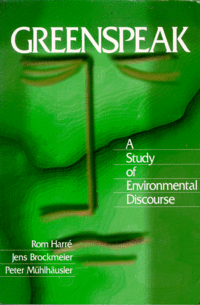

![]()
![]()

The book begins by reviewing alternative theories of language and emphasises the authors' conviction that language is the most significant tool in human 'meaning-making'. Attention to 'Greenspeak' is important given that it is through language that we understand our environment and discuss and negotiate environmental issues. The resources available in English to talk about the environment are considered with the authors concluding that our environmental vocabulary is impoverished and the grammatical structures of our language obstruct some potentially useful discursive developments. This has the effect of rendering much environmental debate uninformed and unhelpful. The rhetorical use of science in Greenspeak is then outlined before the book moves on to analyse the narrative structures typically found, the ways in which metaphors are employed and the expression of time in environmental discourse.
The book then changes tack somewhat to focus upon 'the ecology of language'. This section emphasises the need to preserve languages as potential resources of new metaphors, knowledge and perspectives and draws attention to the conditions which languages need in order to survive. An interesting relationship is outlined between the loss of biological diversity and the loss of linguistic diversity. The two often go together as indigenous knowledge and languages are lost along with local biodiversity as a result of 'development'. The authors illustrate this point with the example of a logging programme in Papua New Guinea which has led to the disappearance of species of plants and at the same time threatened the rich local knowledge of the habitat through the importing of foodstuffs and the emphasis on the acquisition of non-traditional knowledge in government schools. While the authors caution against the selective ransacking of insights from other languages as a form of cultural imperialism, they conclude that more reliable environmental knowledge could be generated by pooling the insights generated by different languages.
There are a number of aspects of the book which I found frustrating. My main complaint is that there much relevant work which is never mentioned. For example, within the sociology of the environment there are a number of studies which explore environmental dialogue and discourse, the social construction of the environment and nature, and the need for multiple environmental perspectives. The authors may well be breaking new ground within linguistics but there is much here that is not novel for sociologists. One of my other problems with the book relates to the fact that its primary intended audience is clearly linguists. There are sections which are difficult to understand if you are not fluent in linguist-speak. My other frustration was methodological. While the book presents itself as a grounded analysis of examples of 'Greenspeak' (with the authors outlining the texts which they have considered as data at the start) much of the analysis is at a somewhat general level and does not present enough of the texts in question to make the analysis transparent.
That said there is much that is engaging and thought provoking within this book. It will be particularly useful for sociologists interested in the discursive and social construction of environmental issues.
Kate Burningham
University of Surrey